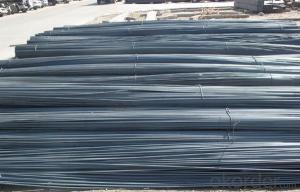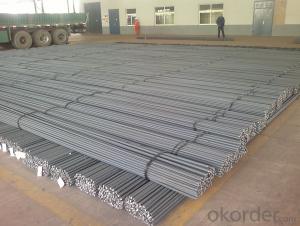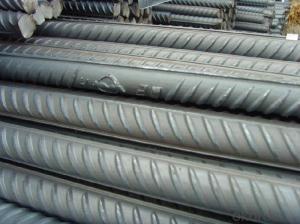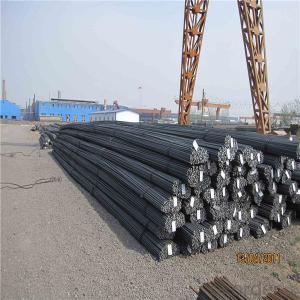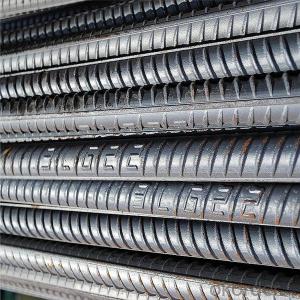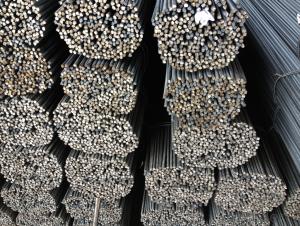Deformed Steel Bar Iron Bars for Construction
- Loading Port:
- Tianjin
- Payment Terms:
- TT or LC
- Min Order Qty:
- 24 m.t.
- Supply Capability:
- 35000 m.t./month
OKorder Service Pledge
OKorder Financial Service
You Might Also Like
Product Description:
OKorder is offering Deformed Steel Bar Iron Bars for Construction at great prices with worldwide shipping. Our supplier is a world-class manufacturer of steel, with our products utilized the world over. OKorder annually supplies products to European, North American and Asian markets. We provide quotations within 24 hours of receiving an inquiry and guarantee competitive prices.
Product Applications:
Deformed Steel Bar Iron Bars for Construction are ideal for structural applications and are widely used in the construction of buildings and bridges, and the manufacturing, petrochemical, and transportation industries.
Product Advantages:
OKorder's Deformed Steel Bar Iron Bars for Construction are durable, strong, and resist corrosion.
Main Product Features:
· Premium quality
· Prompt delivery & seaworthy packing (30 days after receiving deposit)
· Corrosion resistance
· Can be recycled and reused
· Mill test certification
· Professional Service
· Competitive pricing
Product Specifications:
iron bars for construction
Diameter 10-40mm
Grade: ASTM A615 Gr60; BS4999 Gr500
Size: 10#-40#
Length: 6M-12M
| Name | Deformed bar, steel rebar |
| Place of origin | China (mainland) |
| Material | HRB335, HRB400, HRB500, BS4449:2008 GR.460B / GR.500B ASTM A615 GR.40 / GR.60 |
| Standard | ASTM, BS, GB |
| Diameter | 8mm-50mm |
| Length | 9m,12m |
| Application | Widely used in construction industry for reinforcing concret |
| Trasportation | By sea(20' 40' container, BULK VESSEL), By rail |
FAQ:
Q1: Why buy Materials & Equipment from OKorder.com?
A1: All products offered byOKorder.com are carefully selected from China's most reliable manufacturing enterprises. Through its ISO certifications, OKorder.com adheres to the highest standards and a commitment to supply chain safety and customer satisfaction.
Q2: How do we guarantee the quality of our products?
A2: We have established an advanced quality management system which conducts strict quality tests at every step, from raw materials to the final product. At the same time, we provide extensive follow-up service assurances as required.
Q3: How soon can we receive the product after purchase?
A3: Within three days of placing an order, we will begin production. The specific shipping date is dependent upon international and government factors, but is typically 7 to 10 workdays.
Q4: What makes stainless steel stainless?
A4: Stainless steel must contain at least 10.5 % chromium. It is this element that reacts with the oxygen in the air to form a complex chrome-oxide surface layer that is invisible but strong enough to prevent further oxygen from "staining" (rusting) the surface. Higher levels of chromium and the addition of other alloying elements such as nickel and molybdenum enhance this surface layer and improve the corrosion resistance of the stainless material.
Q5: Can stainless steel rust?
A5: Stainless does not "rust" as you think of regular steel rusting with a red oxide on the surface that flakes off. If you see red rust it is probably due to some iron particles that have contaminated the surface of the stainless steel and it is these iron particles that are rusting. Look at the source of the rusting and see if you can remove it from the surface.
Images:
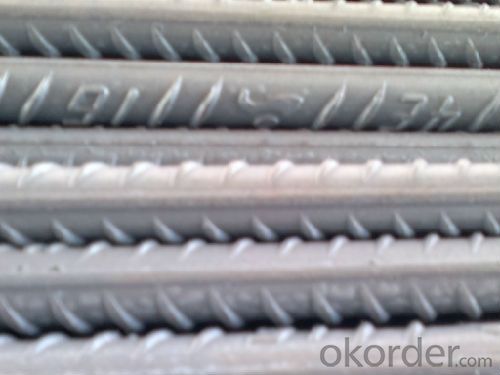
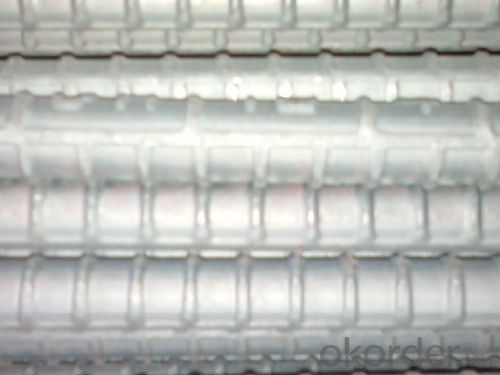
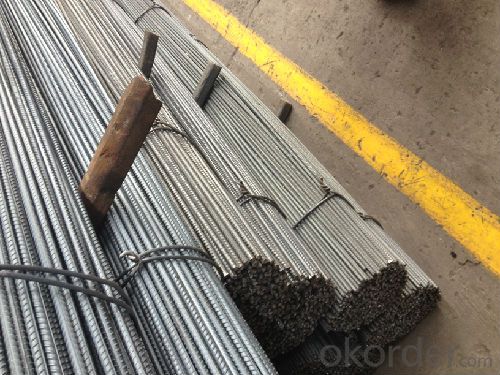
- Q: What are the safety precautions to be followed while working with steel rebars?
- To prevent accidents and injuries while working with steel rebars, it is essential to adhere to specific safety measures. Consider the following precautions: 1. Personal Protective Equipment (PPE): Ensure that you always wear suitable PPE, including safety glasses, gloves, hard hats, and steel-toed boots. These items will shield you from potential dangers like falling objects, sharp edges, and flying debris. 2. Training and Knowledge: Before handling steel rebars, make sure you have undergone proper training and understand the associated safety protocols. Familiarize yourself with the equipment used and comprehend the potential risks involved. 3. Proper Lifting Techniques: Handling steel rebars can be challenging due to their weight and awkward shape. Always utilize correct lifting techniques, such as bending your knees and using your legs instead of your back. Do not attempt to lift a rebar that exceeds your capacity; seek assistance if necessary. 4. Secure Storage: Store steel rebars in a designated area that is free from potential obstructions. Stack them in a stable manner to prevent toppling and causing injuries. 5. Safe Handling: When moving steel rebars, exercise caution due to their sharp edges and potential for harm. Employ appropriate lifting equipment, such as cranes or forklifts, if required. Avoid dragging or sliding rebars, as this can lead to strains or sprains. 6. Fall Protection: If working at heights or near open edges, ensure that adequate fall protection measures are in place. This may involve using guardrails, safety harnesses, or safety nets to prevent falls. 7. Fire Safety: Steel rebars can become extremely hot when exposed to heat or flames. Ensure that appropriate fire prevention measures are in place, such as fire extinguishers, and exercise caution when working near flammable materials. 8. Communication: Maintain clear communication with colleagues and supervisors to ensure everyone is aware of their surroundings and potential hazards. Utilize hand signals or radios when working in noisy environments. 9. Regular Inspections: Routinely inspect steel rebars for any defects, such as cracks or sharp edges, that could pose a safety risk. Immediately remove any damaged or faulty rebars from use. 10. First Aid and Emergency Procedures: Familiarize yourself with first aid procedures and emergency protocols in the event of accidents or injuries. Have a well-stocked first aid kit readily available on-site and know the location of the nearest medical facility. By adhering to these safety precautions, you can minimize the likelihood of accidents and injuries while working with steel rebars. Always prioritize your safety and the safety of those around you.
- Q: How do steel rebars help in distributing load in a structure?
- Steel rebars, also known as reinforcement bars, play a crucial role in distributing load in a structure. They are primarily used in reinforced concrete structures to enhance their strength and durability. Rebars are placed strategically within the concrete to counteract the tensile forces that the structure may encounter. Concrete, while strong in compression, is weak in tension. When a load is applied to a structure, such as a building or a bridge, it creates tensile forces that can cause the concrete to crack and fail. By incorporating steel rebars into the concrete, these tensile forces are effectively distributed and transferred to the rebars, preventing the structure from experiencing excessive deflection or collapse. The presence of steel rebars within the concrete creates a composite material that combines the compressive strength of concrete with the high tensile strength of steel. As a result, the structure becomes capable of withstanding a wide range of loads, including dead loads (the weight of the structure itself), live loads (such as occupants or furniture), and environmental loads (like wind or earthquakes). Additionally, rebars also help to control and minimize the propagation of cracks within the concrete. When a crack forms under load, the rebars act as a barrier, preventing the crack from spreading further and compromising the integrity of the structure. This inhibits the development of larger cracks, which could potentially lead to structural failure. Moreover, steel rebars provide stability and reinforcement at critical locations within the structure, such as corners, joints, and areas prone to high stress. By reinforcing these vulnerable areas, the rebars ensure that the load is evenly distributed throughout the structure, reducing the risk of localized failures. In summary, steel rebars are essential in distributing load in a structure by absorbing tensile forces, enhancing the strength of concrete, preventing cracks from propagating, and providing reinforcement at critical locations. They significantly contribute to the overall structural integrity and safety, making them a vital component in construction projects.
- Q: What is the standard diameter of steel rebars?
- The standard diameter of steel rebars typically ranges from 6 millimeters to 50 millimeters, with the most commonly used diameters being 10 millimeters, 12 millimeters, 16 millimeters, and 20 millimeters. The specific diameter of a steel rebar depends on the intended application and structural requirements of the construction project. These rebars are commonly used in reinforced concrete structures to enhance their tensile strength and overall durability.
- Q: What are the factors that determine the spacing of steel rebars in a concrete structure?
- The spacing of steel rebars in a concrete structure is determined by several factors that ensure the structural integrity and strength of the concrete. These factors include: 1. Structural Design: The spacing of rebars is influenced by the structural design requirements and specifications of the concrete structure. Engineers consider the loads, stresses, and forces that the structure will experience and calculate the required reinforcement spacing accordingly. 2. Concrete Strength: The strength of the concrete being used in the structure is an essential factor in determining rebar spacing. Higher-strength concrete may require closer spacing of rebars to provide adequate reinforcement and prevent cracking or failure under load. 3. Rebar Diameter: The diameter of the steel rebars also plays a role in determining the spacing. Thicker or larger diameter rebars may require wider spacing, whereas thinner rebars typically require closer spacing to provide the desired reinforcement. 4. Bar Bending and Placing: The ease of bending and placing the rebars during construction is another important factor. The spacing is often determined by practical considerations, such as ensuring proper access for workers and equipment, and facilitating the concrete pouring process. 5. Environmental Factors: Environmental conditions, such as exposure to corrosive substances or extreme weather conditions, can influence the spacing of rebars. Closer spacing may be required in corrosive environments to provide additional protection against rust and deterioration. 6. Building Codes and Regulations: Building codes and regulations set by local authorities or relevant organizations also dictate the minimum requirements for rebar spacing in concrete structures. These codes ensure compliance with safety standards and provide guidelines for construction practices. Overall, the spacing of steel rebars in a concrete structure is a critical aspect of ensuring its strength, durability, and resilience. It is determined by a combination of structural design, concrete strength, rebar diameter, construction practicalities, environmental considerations, and adherence to building codes and regulations.
- Q: Can steel rebars be used in the construction of office buildings?
- Indeed, office buildings can utilize steel rebars for construction purposes. When it comes to concrete structures, such as office buildings, steel rebars are frequently employed as reinforcements. By enhancing the concrete's resilience and rigidity, they contribute to its enhanced ability to withstand cracks and bending. Consequently, the incorporation of steel rebars guarantees the structural soundness of the building, particularly in regions subjected to substantial stress or load-bearing demands. Moreover, steel rebars boast durability and longevity, rendering them a dependable option for construction endeavors.
- Q: How are steel rebars connected or joined together?
- Different methods are used to connect steel rebars depending on the specific application and structural requirements. Steel rebars are typically connected or joined together using the following techniques: 1. Overlapping: An effective method involves overlapping two rebars to create a continuous length of reinforcement. The overlapping length must meet the specified design requirements and is usually secured using steel tie wires or mechanical connectors. 2. Welding: Another option is to join steel rebars through welding. This process involves melting the ends of the rebars and fusing them together using heat. Welding is suitable for connecting rebars in pre-fabricated structures or when high strength and durability are necessary. 3. Mechanical couplers: Pre-fabricated devices known as mechanical couplers provide a threaded connection between two rebars. These couplers are typically screwed onto the ends of the rebars, creating a strong and reliable connection. Mechanical couplers are commonly used in construction projects where fast installation and ease of use are important. 4. Lap splicing: A widely used method in reinforced concrete structures involves connecting two rebars by overlapping them and securing the overlap with steel tie wires or mechanical connectors. This approach provides adequate strength and continuity. 5. Grouted splicing: In grouted splicing, the ends of two rebars are embedded into a sleeve or coupling filled with grout or epoxy resin. This ensures a strong bond between the rebars, enhancing load transfer and corrosion resistance. It is crucial to adhere to applicable building codes and structural design specifications when selecting the connection method for steel rebars. This ensures the overall integrity and safety of the structure.
- Q: How do steel rebars affect the overall constructability of concrete structures?
- Steel rebars play a crucial role in enhancing the constructability of concrete structures. These reinforcing bars provide strength and stability to the concrete, increasing its load-bearing capacity and resistance to tension and bending forces. By reinforcing the concrete, rebars ensure that the structure can withstand the applied loads and prevent cracking or failure. Additionally, rebars help to control the formation and propagation of cracks, improving the overall durability and lifespan of the concrete structure.
- Q: How are steel rebars protected from theft during construction?
- Steel rebars are protected from theft during construction through various security measures. One common method is to secure the rebars with lockable cages or enclosures that are difficult to break into. Additionally, construction sites often employ security guards to monitor the area and deter potential thieves. Some construction companies also use video surveillance systems to further enhance security. These measures collectively help prevent the theft of steel rebars and ensure their safety during construction.
- Q: How are steel rebars used in road and pavement construction?
- Steel rebars are used in road and pavement construction to reinforce the concrete structures and provide strength and durability to withstand heavy traffic loads and environmental conditions. They are typically placed within the concrete to prevent cracking and enhance the overall structural integrity, ensuring the longevity and stability of the roads and pavements.
- Q: What is the carbon content of thread steel?
- It is understood that carbon is the main element determining the performance of steel, because changes in carbon content directly lead to changes in crystal structure. With the increase of carbon content, the strength and hardness of the threaded steel increase, while the plasticity and toughness decrease. When the carbon content is more than 1%, the strength of the rebar decreases. The increase of carbon content also reduces the weldability and corrosion resistance of steel, and increases the cold brittleness and aging tendency of steel.
Send your message to us
Deformed Steel Bar Iron Bars for Construction
- Loading Port:
- Tianjin
- Payment Terms:
- TT or LC
- Min Order Qty:
- 24 m.t.
- Supply Capability:
- 35000 m.t./month
OKorder Service Pledge
OKorder Financial Service
Similar products
Hot products
Hot Searches
Related keywords
